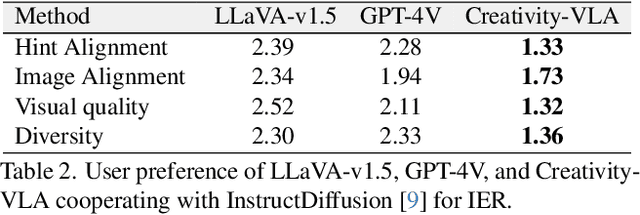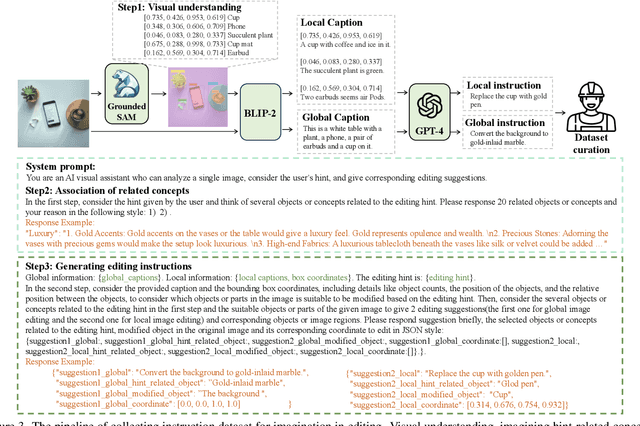Long Mai
REGEN: Learning Compact Video Embedding with (Re-)Generative Decoder
Mar 11, 2025Abstract:We present a novel perspective on learning video embedders for generative modeling: rather than requiring an exact reproduction of an input video, an effective embedder should focus on synthesizing visually plausible reconstructions. This relaxed criterion enables substantial improvements in compression ratios without compromising the quality of downstream generative models. Specifically, we propose replacing the conventional encoder-decoder video embedder with an encoder-generator framework that employs a diffusion transformer (DiT) to synthesize missing details from a compact latent space. Therein, we develop a dedicated latent conditioning module to condition the DiT decoder on the encoded video latent embedding. Our experiments demonstrate that our approach enables superior encoding-decoding performance compared to state-of-the-art methods, particularly as the compression ratio increases. To demonstrate the efficacy of our approach, we report results from our video embedders achieving a temporal compression ratio of up to 32x (8x higher than leading video embedders) and validate the robustness of this ultra-compact latent space for text-to-video generation, providing a significant efficiency boost in latent diffusion model training and inference.
MotionCanvas: Cinematic Shot Design with Controllable Image-to-Video Generation
Feb 06, 2025



Abstract:This paper presents a method that allows users to design cinematic video shots in the context of image-to-video generation. Shot design, a critical aspect of filmmaking, involves meticulously planning both camera movements and object motions in a scene. However, enabling intuitive shot design in modern image-to-video generation systems presents two main challenges: first, effectively capturing user intentions on the motion design, where both camera movements and scene-space object motions must be specified jointly; and second, representing motion information that can be effectively utilized by a video diffusion model to synthesize the image animations. To address these challenges, we introduce MotionCanvas, a method that integrates user-driven controls into image-to-video (I2V) generation models, allowing users to control both object and camera motions in a scene-aware manner. By connecting insights from classical computer graphics and contemporary video generation techniques, we demonstrate the ability to achieve 3D-aware motion control in I2V synthesis without requiring costly 3D-related training data. MotionCanvas enables users to intuitively depict scene-space motion intentions, and translates them into spatiotemporal motion-conditioning signals for video diffusion models. We demonstrate the effectiveness of our method on a wide range of real-world image content and shot-design scenarios, highlighting its potential to enhance the creative workflows in digital content creation and adapt to various image and video editing applications.
Pushing the Boundaries of State Space Models for Image and Video Generation
Feb 03, 2025



Abstract:While Transformers have become the dominant architecture for visual generation, linear attention models, such as the state-space models (SSM), are increasingly recognized for their efficiency in processing long visual sequences. However, the essential efficiency of these models comes from formulating a limited recurrent state, enforcing causality among tokens that are prone to inconsistent modeling of N-dimensional visual data, leaving questions on their capacity to generate long non-causal sequences. In this paper, we explore the boundary of SSM on image and video generation by building the largest-scale diffusion SSM-Transformer hybrid model to date (5B parameters) based on the sub-quadratic bi-directional Hydra and self-attention, and generate up to 2K images and 360p 8 seconds (16 FPS) videos. Our results demonstrate that the model can produce faithful results aligned with complex text prompts and temporal consistent videos with high dynamics, suggesting the great potential of using SSMs for visual generation tasks.
Progressive Growing of Video Tokenizers for Highly Compressed Latent Spaces
Jan 09, 2025Abstract:Video tokenizers are essential for latent video diffusion models, converting raw video data into spatiotemporally compressed latent spaces for efficient training. However, extending state-of-the-art video tokenizers to achieve a temporal compression ratio beyond 4x without increasing channel capacity poses significant challenges. In this work, we propose an alternative approach to enhance temporal compression. We find that the reconstruction quality of temporally subsampled videos from a low-compression encoder surpasses that of high-compression encoders applied to original videos. This indicates that high-compression models can leverage representations from lower-compression models. Building on this insight, we develop a bootstrapped high-temporal-compression model that progressively trains high-compression blocks atop well-trained lower-compression models. Our method includes a cross-level feature-mixing module to retain information from the pretrained low-compression model and guide higher-compression blocks to capture the remaining details from the full video sequence. Evaluation of video benchmarks shows that our method significantly improves reconstruction quality while increasing temporal compression compared to direct extensions of existing video tokenizers. Furthermore, the resulting compact latent space effectively trains a video diffusion model for high-quality video generation with a reduced token budget.
Real-Time Textless Dialogue Generation
Jan 08, 2025Abstract:Recent advancements in large language models (LLMs) have led to significant progress in text-based dialogue systems. These systems can now generate high-quality responses that are accurate and coherent across a wide range of topics and tasks. However, spoken dialogue systems still lag behind in terms of naturalness. They tend to produce robotic interactions, with issues such as slow response times, overly generic or cautious replies, and a lack of natural rhythm and fluid turn-taking. This shortcoming is largely due to the over-reliance on the traditional cascaded design, which involve separate, sequential components, as well as the use of text as an intermediate representation. This paper propose a real-time, textless spoken dialogue generation model (RTTL-DG) that aims to overcome these challenges. Our system enables fluid turn-taking and generates responses with minimal delay by processing streaming spoken conversation directly. Additionally, our model incorporates backchannels, filters, laughter, and other paralinguistic signals, which are often absent in cascaded dialogue systems, to create more natural and human-like interactions. The implementations and generated samples are available in our repository: https://github.com/mailong25/rts2s-dg
GaussianVideo: Efficient Video Representation via Hierarchical Gaussian Splatting
Jan 08, 2025Abstract:Efficient neural representations for dynamic video scenes are critical for applications ranging from video compression to interactive simulations. Yet, existing methods often face challenges related to high memory usage, lengthy training times, and temporal consistency. To address these issues, we introduce a novel neural video representation that combines 3D Gaussian splatting with continuous camera motion modeling. By leveraging Neural ODEs, our approach learns smooth camera trajectories while maintaining an explicit 3D scene representation through Gaussians. Additionally, we introduce a spatiotemporal hierarchical learning strategy, progressively refining spatial and temporal features to enhance reconstruction quality and accelerate convergence. This memory-efficient approach achieves high-quality rendering at impressive speeds. Experimental results show that our hierarchical learning, combined with robust camera motion modeling, captures complex dynamic scenes with strong temporal consistency, achieving state-of-the-art performance across diverse video datasets in both high- and low-motion scenarios.
TAB: Transformer Attention Bottlenecks enable User Intervention and Debugging in Vision-Language Models
Dec 24, 2024Abstract:Multi-head self-attention (MHSA) is a key component of Transformers, a widely popular architecture in both language and vision. Multiple heads intuitively enable different parallel processes over the same input. Yet, they also obscure the attribution of each input patch to the output of a model. We propose a novel 1-head Transformer Attention Bottleneck (TAB) layer, inserted after the traditional MHSA architecture, to serve as an attention bottleneck for interpretability and intervention. Unlike standard self-attention, TAB constrains the total attention over all patches to $\in [0, 1]$. That is, when the total attention is 0, no visual information is propagated further into the network and the vision-language model (VLM) would default to a generic, image-independent response. To demonstrate the advantages of TAB, we train VLMs with TAB to perform image difference captioning. Over three datasets, our models perform similarly to baseline VLMs in captioning but the bottleneck is superior in localizing changes and in identifying when no changes occur. TAB is the first architecture to enable users to intervene by editing attention, which often produces expected outputs by VLMs.
Improving Linguistic Diversity of Large Language Models with Possibility Exploration Fine-Tuning
Dec 04, 2024



Abstract:While Large Language Models (LLMs) have made significant strides in replicating human-like abilities, there are concerns about a reduction in the linguistic diversity of their outputs. This results in the homogenization of viewpoints and perspectives, as well as the underrepresentation of specific demographic groups. Although several fine-tuning and prompting techniques have been suggested to tackle the issue, they are often tailored to specific tasks or come with a substantial increase in computational cost and latency. This makes them challenging to apply to applications that demand very low latency, such as chatbots and virtual assistants. We propose Possibility Exploration Fine-Tuning (PEFT), a task-agnostic framework that enhances the text diversity of LLMs without increasing latency or computational cost. Given the same prompt, models fine-tuned with PEFT can simultaneously generate multiple diverse responses, each corresponding with a controllable possibility number. Experiments on dialogue and story generation tasks demonstrate that PEFT significantly enhances the diversity of LLM outputs, as evidenced by lower similarity between candidate responses. Since PEFT emphasizes semantic diversity over lexical diversity, it can also notably reduce demographic bias in dialogue systems. The implementations and datasets are available in our repository: https://github.com/mailong25/peft_diversity
Empowering Visual Creativity: A Vision-Language Assistant to Image Editing Recommendations
May 31, 2024



Abstract:Advances in text-based image generation and editing have revolutionized content creation, enabling users to create impressive content from imaginative text prompts. However, existing methods are not designed to work well with the oversimplified prompts that are often encountered in typical scenarios when users start their editing with only vague or abstract purposes in mind. Those scenarios demand elaborate ideation efforts from the users to bridge the gap between such vague starting points and the detailed creative ideas needed to depict the desired results. In this paper, we introduce the task of Image Editing Recommendation (IER). This task aims to automatically generate diverse creative editing instructions from an input image and a simple prompt representing the users' under-specified editing purpose. To this end, we introduce Creativity-Vision Language Assistant~(Creativity-VLA), a multimodal framework designed specifically for edit-instruction generation. We train Creativity-VLA on our edit-instruction dataset specifically curated for IER. We further enhance our model with a novel 'token-for-localization' mechanism, enabling it to support both global and local editing operations. Our experimental results demonstrate the effectiveness of \ours{} in suggesting instructions that not only contain engaging creative elements but also maintain high relevance to both the input image and the user's initial hint.
SPICED: News Similarity Detection Dataset with Multiple Topics and Complexity Levels
Sep 21, 2023Abstract:Nowadays, the use of intelligent systems to detect redundant information in news articles has become especially prevalent with the proliferation of news media outlets in order to enhance user experience. However, the heterogeneous nature of news can lead to spurious findings in these systems: Simple heuristics such as whether a pair of news are both about politics can provide strong but deceptive downstream performance. Segmenting news similarity datasets into topics improves the training of these models by forcing them to learn how to distinguish salient characteristics under more narrow domains. However, this requires the existence of topic-specific datasets, which are currently lacking. In this article, we propose a new dataset of similar news, SPICED, which includes seven topics: Crime & Law, Culture & Entertainment, Disasters & Accidents, Economy & Business, Politics & Conflicts, Science & Technology, and Sports. Futhermore, we present four distinct approaches for generating news pairs, which are used in the creation of datasets specifically designed for news similarity detection task. We benchmarked the created datasets using MinHash, BERT, SBERT, and SimCSE models.
 Add to Chrome
Add to Chrome Add to Firefox
Add to Firefox Add to Edge
Add to Edge